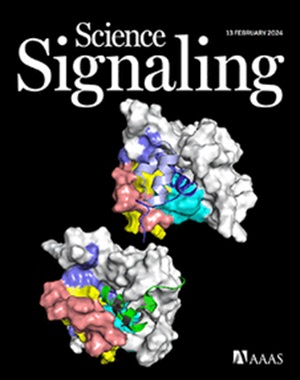淋巴细胞系BTK信号膜结合模块二聚化的条件要求。
IF 6.7
1区 生物学
Q1 BIOCHEMISTRY & MOLECULAR BIOLOGY
引用次数: 0
摘要
布鲁顿酪氨酸激酶(BTK)是免疫细胞的主要药物靶点。BTK的膜结合pleckstrin同源性和tec同源性(PH-TH)结构域是信号转导所必需的。PH-TH模块的二聚化在体外强烈刺激BTK的激酶活性。在这里,我们研究了BTK是否在细胞中使用PH-TH模块二聚化,以及这种二聚化是否为信号传导所必需。为了解决这个问题,我们在Ramos B细胞和Jurkat T细胞中开发了BTK功能的高通量诱变试验。我们测量了PH-TH模块和激酶结构域中数千个点突变的适应度成本,以评估PH-TH模块的二聚化和BTK激酶活性是否对功能是必要的。在Ramos细胞中,我们发现BTK信号既不需要PH-TH二聚化也不需要激酶活性。相反,在Ramos细胞中,PH-TH模块突变增加了膜吸附,甚至以降低PH-TH二聚化为代价,也增强了BTK信号。相反,在Jurkat细胞中,我们发现BTK信号同时依赖于PH-TH二聚化和激酶活性。进化分析表明,在鳐鱼分化之前进化的生物中,BTK蛋白缺乏PH-TH二聚化,但具有活性的激酶结构域,与其他Tec家族激酶相似。因此,PH-TH二聚化是BTK的一个明显特征,随着适应性免疫系统的复杂性增加,BTK进化为对激酶活性施加更严格的调节控制。本文章由计算机程序翻译,如有差异,请以英文原文为准。
Conditional requirement for dimerization of the membrane-binding module for BTK signaling in lymphocyte cell lines
Bruton’s tyrosine kinase (BTK) is a major drug target in immune cells. The membrane-binding pleckstrin homology and tec homology (PH-TH) domains of BTK are required for signaling. Dimerization of the PH-TH module strongly stimulates the kinase activity of BTK in vitro. Here, we investigated whether BTK dimerizes in cells using the PH-TH module and whether this dimerization is necessary for signaling. To address this question, we developed high-throughput mutagenesis assays for BTK function in Ramos B cells and Jurkat T cells. We measured the fitness costs for thousands of point mutations in the PH-TH module and kinase domain to assess whether dimerization of the PH-TH module and BTK kinase activity were necessary for function. In Ramos cells, we found that neither PH-TH dimerization nor kinase activity was required for BTK signaling. Instead, in Ramos cells, BTK signaling was enhanced by PH-TH module mutations that increased membrane adsorption, even at the cost of reduced PH-TH dimerization. In contrast, in Jurkat cells, we found that BTK signaling depended on both PH-TH dimerization and kinase activity. Evolutionary analysis indicated that BTK proteins in organisms that evolved before the divergence of ray-finned fishes lacked PH-TH dimerization but had active kinase domains, similar to other Tec family kinases. Thus, PH-TH dimerization is a distinct feature of BTK that evolved to exert stricter regulatory control on kinase activity as adaptive immune systems gained increased complexity.
求助全文
通过发布文献求助,成功后即可免费获取论文全文。
去求助
来源期刊

Science Signaling
BIOCHEMISTRY & MOLECULAR BIOLOGY-CELL BIOLOGY
CiteScore
9.50
自引率
0.00%
发文量
148
审稿时长
3-8 weeks
期刊介绍:
"Science Signaling" is a reputable, peer-reviewed journal dedicated to the exploration of cell communication mechanisms, offering a comprehensive view of the intricate processes that govern cellular regulation. This journal, published weekly online by the American Association for the Advancement of Science (AAAS), is a go-to resource for the latest research in cell signaling and its various facets.
The journal's scope encompasses a broad range of topics, including the study of signaling networks, synthetic biology, systems biology, and the application of these findings in drug discovery. It also delves into the computational and modeling aspects of regulatory pathways, providing insights into how cells communicate and respond to their environment.
In addition to publishing full-length articles that report on groundbreaking research, "Science Signaling" also features reviews that synthesize current knowledge in the field, focus articles that highlight specific areas of interest, and editor-written highlights that draw attention to particularly significant studies. This mix of content ensures that the journal serves as a valuable resource for both researchers and professionals looking to stay abreast of the latest advancements in cell communication science.
 求助内容:
求助内容: 应助结果提醒方式:
应助结果提醒方式:


